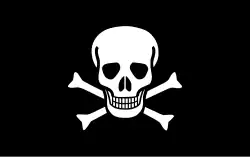USS Carolina (1812)
| History | |
|---|---|
| Name | USS Carolina |
| Launched | 10 November 1812 |
| Commissioned | 4 June 1813 |
| Fate | Sunk 27 December 1814 |
| General characteristics | |
| Displacement | 230 tons |
| Length | 89 ft 6 in (27.28 m) |
| Beam | 24 ft 4 in (7.42 m) |
| Complement | 100 officers and men |
| Armament |
|
| Notes | |
USS Carolina, a schooner, was the only ship of the United States Navy to be named for the British colony that became the states of North Carolina and South Carolina.
Service
Her keel was laid down at Charleston, South Carolina. She was purchased by the Navy while still on the stocks, launched on 10 November 1812, and commissioned on 4 June 1813 with Lieutenant J. D. Henley in command.[1]
Carolina set sail for New Orleans, Louisiana, and while making her passage, captured the British schooner Shark. Arriving at New Orleans 23 August 1814, she began an active career of patrol directed against possible British action as well as the pirates that infested the Caribbean Sea. On 16 September 1814, Carolina attacked and destroyed the stronghold of the notorious Jean Lafitte on the island of Barataria.[1]
Carolina, with the others of the small naval force in the area, carried out the series of operations which gave General Andrew Jackson time to prepare the defense of New Orleans when the British threatened the city in December 1814. On 23 December, she dropped down the river to the British bivouac which she bombarded with so telling an effect as to make a material contribution to the eventual victory.[1]
As the British stiffened their efforts to destroy the naval force and to take the city, Carolina came under heavy fire from enemy artillery on 27 December.[a] The heated shot set her afire, and her crew was forced to abandon her.[b][4][c] Shortly after, she exploded.[1]
Jackson ordered the Carolina's surviving crew to be stationed on the west bank and provide covering fire for any British assault on the river road to Line Jackson (name of the U.S. defensive line at the Rodriguez Canal) and New Orleans.
References
Notes
- ^ 'A battery was thrown up during the two succeeding nights on the brink of the river opposite to where the Carolina lay; and at dawn a heavy cannonade of red hot shot and shell was opened upon her from eleven guns and a mortar. She responded briskly, but very soon caught fire and blew up... Her destruction removed the last obstacle to the immediate advance of the army.'[2]
- ^ The Carolina was only blown up because the wind happened to fail her [from sailing away][3]
- ^ 'The late United States Schooner Carolina destroyed on the 27th by hot shot from a Battery, erected by the Enemy, unknown to us.'[5]
Citations
- ^ a b c d "Carolina". DANFS.
- ^ Roosevelt 1900, pp. 215–216.
- ^ Roosevelt 1900, p. 241.
- ^ Davis 2019, pp. 137–139.
- ^ Hughes & Brodine 2023, p. 984.
Bibliography
- Davis, William C. (2019). The Greatest Fury: The Battle of New Orleans and the Rebirth of America. London, UK: Dutton Caliber, an imprint of Penguin Random House. ISBN 978-0-39-958522-7.
- Hughes, Christine F.; Brodine, Charles E., eds. (2023). The Naval War of 1812: A Documentary History, Vol. 4. Washington: Naval Historical Center (GPO). ISBN 978-1-943604-36-4.
- Roosevelt, Theodore (1900). The Naval War of 1812. Vol. II. Annapolis: Naval Institute Press.
 This article incorporates text from the public domain Dictionary of American Naval Fighting Ships. The entry can be found here.
This article incorporates text from the public domain Dictionary of American Naval Fighting Ships. The entry can be found here.
